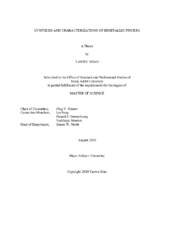| dc.description.abstract | One remarkable feature of pincer system is its high tunability via alteration of functional groups. However, the effect of introducing additional metal is still fairly underexplored. Bimetallic
complexes are important objects of investigations because both metal fragments have a role to play in chemical reactions, structural support and properties of interest. Around the late 2000s, the Klein Gebbink group reported the synthesis of a series of peripherally metalated pincer-porphyrin hybrids. Their subsequent examination demonstrated a positive relationship between the electron richness of their porphyrin rings and Heck reaction yields catalyzed by pincer moiety. Reciprocally, the incorporation of pincer metal center gives a substantial influence on the electronic absorption and emission properties of the porphyrin core.
Inspired by this, a wide variety of additional metals, such as zinc, magnesium, tantalum and zinc, were successfully incorporated closely to the bis(benzimidazolyl)methane backbone of pincer in different geometry. This type of novel hetero-bimetallic pincer complexes, (ᴹ²PᴺCᴺPⁱᴾͬ)M₁L and ᴹ²[(PᴺCᴺPⁱᴾͬ)M₁L]₂, demonstrate high planarity, rigidity and a capacity of reversible multi-redox events differing from traditional functional group-tuned pincer system or heterogenous bimetallic system. In addition, the ease of modulation allows a potential construction of more complicated structure.
Another unique type of these bimetallic complexes is Janus pincers named by the fusion of two identical pincer fragments. Previous research demonstrated that this structure provides a higher rigidity and catalytic activity as well as another dimension to further extend the structure. Here, we managed to synthesize a novel type of Janus bis-pincer complex using diphenylpyrazine as the bridging scaffold. A high planarity, rigidity and redox reversibility were observed, suggesting their potential to be utilized structurally and electronically. | en |


